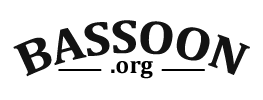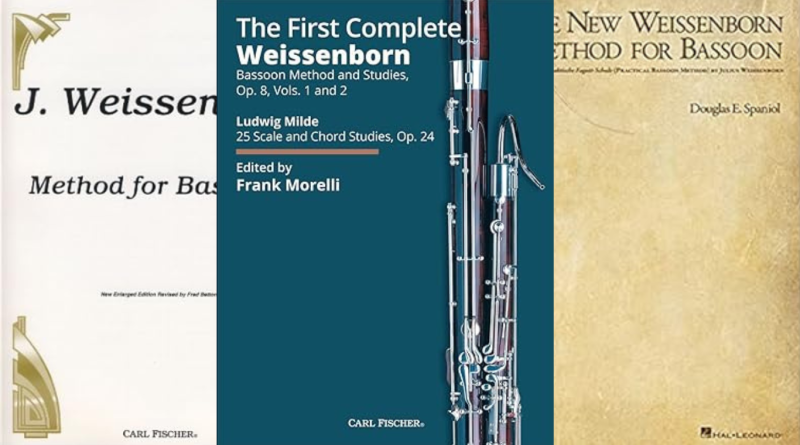Method Books for Bassoon Students
Are you a new teacher wondering which method book to use? Or perhaps you have a current student who is not progressing. Placing your student in the right method book can revolutionize your teaching experience. It took me a few years to understand that not every student must begin with Weissenborn.
In this post I will highlight the three different books that I use. Then I will discuss when I use each of these methods. I understand that there are many more available. Please leave your feedback about your favorite method in the comments section.
Kristen Wolfe Jensen’s Music and the Bassoon
If you haven’t checked out www.musicandthebassoon.com yet, it’s really great. I wrote a review of the website, but since that time I have started using the materials available there as a stand-alone method book. You can download all of the lesson PDFs and compile them into one document.
This method moves slowly (especially when compared to the Weissenborn options below). In a few instances, the slowness of the method does get a little strange. For example, low C isn’t introduced until lesson 42 of 50.
The slower pace has worked wonders for my non-practicers and students who need accommodations. Those students who weren’t practicing when assigned Weissenborn suddenly came to life when I switched them to Music and the Bassoon. They like to play along with the duets on the website. They like that the tunes are recognizable. They like that some excerpts have piano accompaniment. I like that ear training is built in. I like that flicking is reinforced again and again. And I like that many of my favorite excerpts from the Weissenborn book are included.
Weissenborn’s Method for Bassoon
The tried and true bible of bassoon, Weissenborn’s Method for Bassoon has been in use since 1887. The musical examples are well written (I particularly like the duets), but there are some real flaws. The fingering chart that comes with the book is ridiculous. The explanations are confusing and sometimes just plain wrong (i.e. portamento vs portato). New rhythms and time signatures are introduced in a haphazard way, often leaving students confused. Flicking/venting is barely mentioned; a student working through the book alone would be totally confused.
There have been attempts at modernizing Weissenborn’s method. There are two newer editions to choose from.
- Doug Spaniol has a revised version available that addresses many of issues stated above. It also includes some new material meant to bridge some gaps left by Weissenborn. It’s a major improvement. I used it for a few years before the Morelli edition came out (see the next paragraph). The New Weissenborn Method for Bassoon still doesn’t address the basic problem that the method simply moves too quickly for some students. However, I do like the section on ornamentation in this edition. (Read my full review of this edition.)
- Frank Morelli edited a new edition that came out in 2019. This is my new favorite edition. It’s called The First Complete Weissenborn and it fixes the issues of the old Weissenborn edition, adds a bunch of really fun material (duets!), and it combines Weissenborn’s method with his two books of studies (op. 8, no. 1 & 2, see below). It also includes the Milde scale and chord exercises. This is really a great book. It’s heavy. And a little more expensive. It comes with a traditional binding or a spiral binding.
Weissenborn’s Bassoon Studies, Op. 8, No. 1
You are probably familiar with Weissenborn’s 50 Advanced Studies. Those studies are part two of his opus 8. Part one is much less well-known. It includes exercises arranged by skill and difficulty. For example, the first section has a limited range and focuses on playing tenuto. The next section increases in difficulty and focuses on playing legato. Staccato, portato, dynamic contrast, marcato, the tenor clef, and ornamentation are covered as well. Then there are scale exercises in all keys followed by interval and chord exercises. It’s a comprehensive book, but it is not for the beginner. I use this book with my talented transfer students, some of whom have been working in Weissenborn’s method. It provides a great opportunity to review concepts that may not have been mastered the first time.
When I use Each Book
Beginners
When I have the luxury of starting a student from day one, I introduce them to www.musicandthebassoon.org and print off the first lesson or two for them. After I have a feel for the kind of student they will be, I will either assign them more lessons from Music and the Bassoon or I will start them in the Morelli edition of Weissenborn’s Method for Bassoon.
Students who have played a while but never had lessons
These students often need a lot of remedial help and are given band music that is far too difficult for them. Once we get a handle on the band music (I have been known to simplify parts for students), I assign an appropriate lesson from Music and the Bassoon (always starting with the discussion of a proper embouchure). As I do with my beginners, I wait a few weeks to get a feel for their practice habits and previous musical background. Then I will assign them either more of Music and the Bassoon or Weissenborn’s method. Those students who have played piano for a number of years often do very well in Weissenborn.
Transfer students from another teacher
These students are always a fun challenge. I’ve had students come to me with Rubank books, just their band book, Weissenborn’s method–you name it. If they are working in a something like Rubank, I’ll finish up the current book with them and then move them over to one of my preferred methods. If the student is at an intermediate level, I almost always use Weissenborn’s Op. 8, No. 1 with them. It’s a great review no matter their previous method book.
Students who struggle with tenor clef
The tenor clef section in Weissenborn’s method is not great. It’s better in his Op. 8 No. 1. No matter the main method for each student, when it comes time to work on tenor clef, I always give them the materials from at least two, if not three, of the methods. See more ideas for teaching tenor clef.
This post was originally published on teachbassoon.com. Used here with permission.

